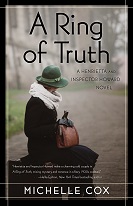The Unexpected Twist, and Other Delights, of Writing Mystery
 Writing mystery, I find, is nearly as suspenseful as reading it, though I obviously know who the killer is way before the reader. Some mystery authors, however, have confessed to being as surprised by who comes forward as the killer as the reader eventually is!
Writing mystery, I find, is nearly as suspenseful as reading it, though I obviously know who the killer is way before the reader. Some mystery authors, however, have confessed to being as surprised by who comes forward as the killer as the reader eventually is!
Personally, I can’t abide that level of anguish, so I plot out all of the highlights of the case before I even start writing, as well as how the sub plots are going to weave in and out. But even with all of that advanced planning, things do sometimes have a way of twisting and turning beyond what I originally imagined.
All writers are subject to their characters’ demands from time to time, but the mystery writer can only give in so often because she must remain ever vigilant to the plot. There can be no veering off topic, as one might be tempted to do when writing some other, broader genre, like, let’s say, pure literary fiction.
The success of a mystery lies in the plot, so as the author, I am forced to keep my chapters tight and purposeful in order to move the story along in what is hopefully a thrilling, well-paced manner. There is not a lot of room for extraneous fluff. This might seem to be a bridled way to write, but it actually makes things easier. I know ahead of time what each chapter is supposed to accomplish.
Oddly enough, this attention to plot—to the unfolding of the mystery—has a roundabout way of developing the characters, as well. One of the appeals of writing mystery is sprinkling clues and red herrings about for the reader and the characters to discover, which gives them (the characters, that is) something to do. So while they are busy putting the clues together, this gives me, the author, a chance to breathe some life and color into them. Make them three-dimensional and real. Now I can reveal the nightmares the hero still has from the war or that the heroine’s father killed himself long ago or that they both share a love of Sloe Gin fizzes.
 And, naturally, throwing two characters together who may or may not have a history with each other and who are called upon to complete a task, is the perfect recipe to whip up a romance, or at least some frosting in the form of sexual tension, which naturally adds to the overall tension of the story. With two levels of suspense—the mystery and the love-interest (will they, won’t they?)—the reader’s emotional ante is decidedly upped.
And, naturally, throwing two characters together who may or may not have a history with each other and who are called upon to complete a task, is the perfect recipe to whip up a romance, or at least some frosting in the form of sexual tension, which naturally adds to the overall tension of the story. With two levels of suspense—the mystery and the love-interest (will they, won’t they?)—the reader’s emotional ante is decidedly upped.
And last but not least, for those writers who love writing side characters and sub plots, such as I do, mystery is a genre that welcomes them with open arms. One could almost argue that side characters are almost essential. Not only are they there to support the main characters, but they add a diversion, help hide or reveal clues (or red herrings!) and sometimes serve to lighten the more serious main plot of the mystery. Again, they have a reason to exist, a reason to be in the story; they aren’t just stand-ins decorating your chapter whom your editor might be tempted to chop out.
People say that writing genre fiction is formulaic, and therefore restrictive, but I find the opposite is true. With a definite frame to the structure, I can relax within it, fitting the puzzle pieces together each time in a new way, which, of course, naturally lends itself to the birth of a series. And what could be better than that? Getting to live a bit longer with the lovely characters you’ve created and to further inhabit their world, book after book, is cherry on the top for any writer . . . unless, of course, there’s a twist, and someone gets killed . . . but that’s not always up to me!
—
Michelle Cox holds a BA in English literature from Mundelein College, Chicago, and is the author of the award-winning A Girl Like You, the first in the Henrietta and Inspector Howard series. She is known for her wildly popular blog, How to Get Your Book Published in 7,000 Easy Steps – A Practical Guide, as well as her charming Novel Notes of Local Lore, a blog dedicated to Chicago’s forgotten residents. Cox lives with her husband and three children in the suburbs of Chicago.
Visit her page on Facebook https://www.facebook.com/michellecoxwrites and follow her on Twitter: https://twitter.com/michellecox33
Category: Contemporary Women Writers, How To and Tips
























Comments (2)
Trackback URL | Comments RSS Feed
Sites That Link to this Post